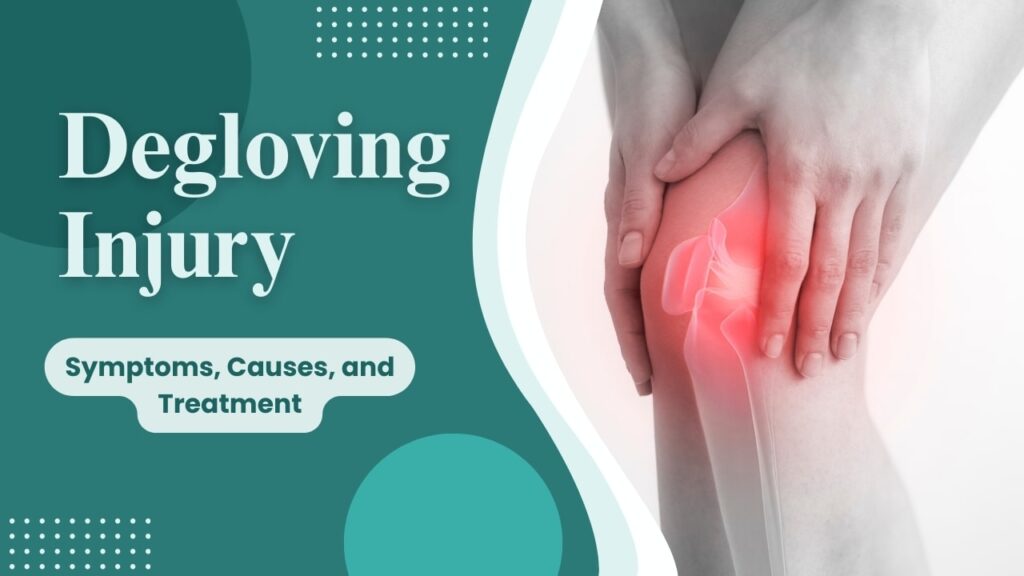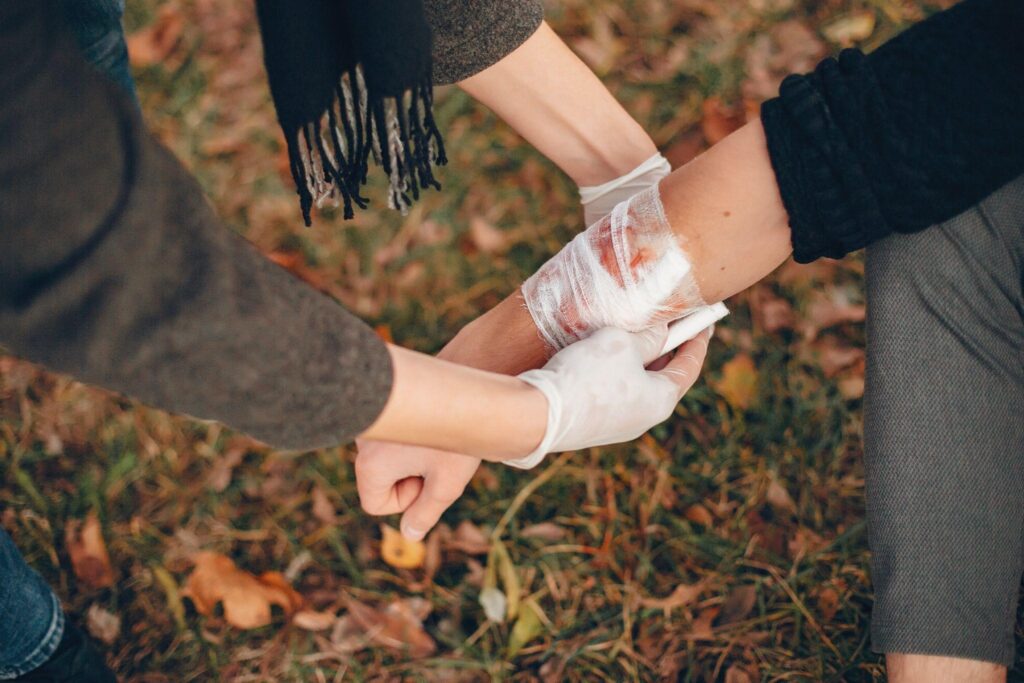Last updated on May 20th, 2025 at 11:49 am

Degloving injuries are one of the most traumatic and severe types of trauma that can happen to a human body. It happens when the skin and the soft tissues are violently peeled off from the underlying muscles, bones, and tendons, like a glove. It is one of the rarest but most devastating kinds of injury that can lead to severe tissue damage, infection, and often permanent disfigurement. The extent of degloving injuries varies in severity with location and trauma extent, thus requiring urgent medical intervention to prevent complications from arising.
What is a Degloving Injury ?
A degloving injury occurs when the skin and subcutaneous tissue are torn away from the underlying muscle, fascia, or bone. “Degloving” refers to the skin being removed in a manner similar to peeling off a glove. These injuries may occur as a result of severe trauma such as car accidents, industrial accidents, or animal attacks. The most commonly affected areas include the hands, legs, and face.
Types of Degloving Injuries
Degloved Hand :
This is one of the most common sites of injury, especially in an industrial or motor vehicle accident. It may result from a machinery, a motorbike crash, or severe crush injuries. The force can strip the skin, leaving the muscles and bones exposed, attached to the bones and tendons only.
Degloved Face :
A degloved face is one of the rarest and most severe injuries. This may occur during accidents such as a car crash or fall from a significant height, with complete or partial loss of tissue on the face. A degloved face can look dreadful since the skin can be pulled off from the skull with severe damage to facial structures, such as eyes, nose, and mouth.
Mouth Larva Degloved :
In extremely severe cases, especially those arising after significant facial trauma, “mouth larva degloved” conditions have been known to occur – a condition where tissue about the mouth is pulled from the bone. This situation would occur in massive facial trauma involving high-impact forces; secondary issues might include infections or necrosis.
Ring Avulsion and Degloving :
It is a special type of degloving that is created by the avulsion of the ring from a finger when forcibly torn due to pulling, taking up with it, a layer of skin. In industrial working settings, when a person’s ring caught between two or more mechanical things, including heavy objects or machine parts, it causes a very sore injury in a finger plus surrounding tissues.
Symptoms of a Degloving Injury
The symptoms of a degloving injury can vary depending on the location and severity of the trauma. Some common symptoms include:
- Severe Pain : The skin and underlying tissues are often torn away, leading to excruciating pain.
- Visible Tissue Damage : The skin may be visibly separated from the underlying muscles, bones, or tendons, and there may be visible exposure of bone or muscle.
- Bleeding : Heavy bleeding is common, particularly where the main blood vessels are cut.
- Swelling and bruising : Swelling of the injured area is normally accompanied by bruising
- Loss of function : Any part of the hands or fingers and the face, would have an inability to be moved or controlled
- Numbness : Damage to the nerves that lead to the injury might have the effects of numbness or even paresthesia.
For example, a degloved face picture will often show extensive damage with exposed facial structures and sometimes disfigurement, making it a highly distressing condition.
Causes of Degloving Injuries
Degloving injuries occur as a result of blunt force trauma or shearing forces that pull the skin away from underlying tissues. Here are some common causes:
- Motor Vehicle Accidents: The skin is often ripped off the body in high-speed crashes, especially when the body is dragged or hit by vehicles or debris.
- Industrial Accidents: Machinery accidents, especially those involving rotating parts or conveyor belts, can easily cause a degloving injury, especially to the hands and arms.
- Animal Attacks: Large animal bites, including those from dogs or wild animals, can cause degloving to the limbs, face, or neck.
- Crush Injuries: Crushing forces, such as building collapses or industrial equipment malfunction, result in significant degloving injuries.
- Burns and Electrical Injuries: It may happen in very rare instances, such as with major burns or electrical injuries that may cause the skin to detach from the muscles due to the severity of the burn.
Treatment of Degloving Injuries
The treatment for a degloving injury will depend on the extent of the injury and where the injury has occurred. Generally speaking, it includes several key steps:
Emergency Care:
- The first step in managing a degloving injury is to stop any bleeding. Applying direct pressure and elevating the injured limb can help control bleeding.
- If the injury involves a degloved hand or face, the affected area should be protected with sterile bandages or a clean cloth.
Surgical Intervention:
- Debridement: Once the patient is stable, the injured area may need to be cleaned and debrided to remove dead or damaged tissue.
- Reattachment or Grafting: In cases where the skin is still viable, it may be reattached surgically. However, if the skin is too damaged, skin grafts may be necessary to cover the wound. For a degloved face, reconstructive surgery is often required to restore the appearance and function of the face.
- Bone and Tendon Repair: If the degloving injury involves damage to bones, tendons, or muscles, reconstructive surgery may also be required to repair these structures.
Infection Control:
- Degloving injuries are highly susceptible to infections due to the exposure of deep tissues. Antibiotics and careful wound care are essential to prevent infection.
Rehabilitation:
- Rehabilitation may involve physical therapy to regain function, especially in cases of degloved hands or limbs. For facial injuries, rehabilitation may focus on restoring facial movement and aesthetics.

Prognosis and Complications
The prognosis of a degloving injury depends on the severity of the injury and the promptness of treatment. Early intervention, including proper wound care, infection control, and reconstructive surgery, can improve outcomes significantly.
Complications include:
- Infection: It can lead to sepsis if deep tissue infections are not properly treated.
- Scarring and Disfigurement: Even after surgery, scarring and permanent disfigurement can be especially prominent in facial injuries.
- Nerve Damage: It may result in the loss of sensation or movement in the affected area due to nerve damage.
- Chronic Pain: Sometimes, long-term pain is caused by nerve damage or tissue loss.
Conclusion
Among the most severe and traumatic kinds of injury, degloving injuries usually result in considerable tissue, functional, and aesthetic loss. Whatever portion is involved, from the degloved hand to the degloved face, or other areas, immediate medical attention should be sought. With prompt and appropriate treatment-including debridement, surgical repair, and rehabilitation-many individuals will regain functionality and at least minimize disfigurement. However, these injuries often have long-term complications as they lead to scarring and chronic pain. There is an awareness of the causes, symptoms, and treatments for degloving injuries that can be used by individuals to prevent the injuries and obtain prompt care when necessary.
If you have had a degloving injury or witnessed someone having it, you need to know how bad the situation is and act in time to minimize damage.
FAQs on Degloving Injury Symptoms, Causes, and Treatment
1. What are the typical symptoms of a degloving injury?
Degloving injuries are accompanied by severe pain, massive bleeding, and obvious damage to tissues, including bare bones or muscles. Swelling, bruising, and loss of function in the affected area is common. Numbness may also occur if nerves are damaged.
2. What causes degloving injuries?
Such injuries are caused by impact trauma or shearing forces, usually resulting from auto accidents, industrial mishaps, or animal attacks. The strong force rips the skin and tissue, peeling it off from other interior structures such as bones and muscles, tearing it severely.
3. How is a degloving injury treated?
Treatment includes stopping bleeding, cleaning the wound, and surgical interventions like reattaching viable tissue or skin grafts. Antibiotics are used to prevent infection, and rehabilitation helps restore function, especially for hands or facial injuries.
4. Can degloving injuries lead to long-term complications?
Yes, complications consist of infection, scarring, chronic pain and numbness or paralysis caused due to nerve damage. There can be disfigurement in facial degloving injuries even after reconstructive surgeries. Early treatment makes for a much better prognosis.